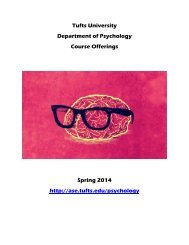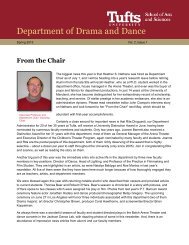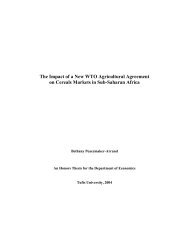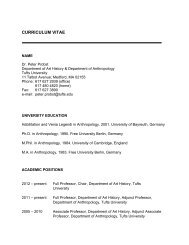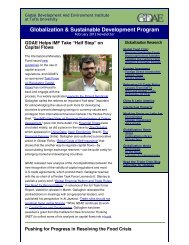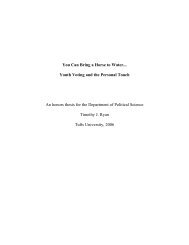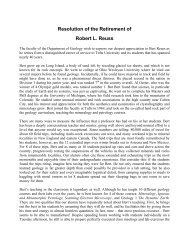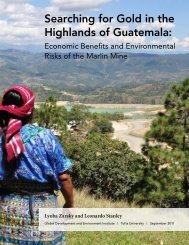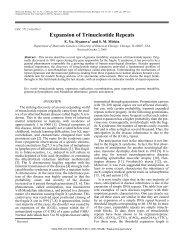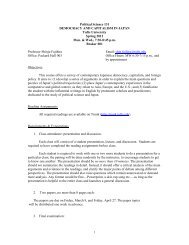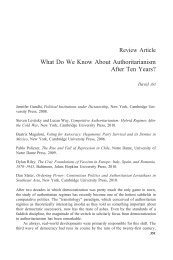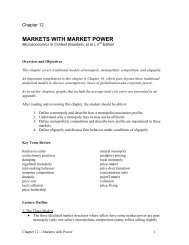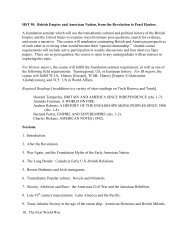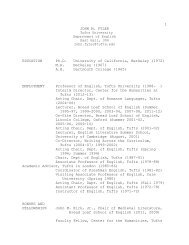Changing Course to Feed the World in 2050 - Tufts University
Changing Course to Feed the World in 2050 - Tufts University
Changing Course to Feed the World in 2050 - Tufts University
You also want an ePaper? Increase the reach of your titles
YUMPU automatically turns print PDFs into web optimized ePapers that Google loves.
Globalization Commentaries<br />
First published by <strong>the</strong> Triple Crisis Blog<br />
Oc<strong>to</strong>ber 3, 2013<br />
<strong>Chang<strong>in</strong>g</strong> <strong>Course</strong> <strong>to</strong> <strong>Feed</strong> <strong>the</strong> <strong>World</strong> <strong>in</strong> <strong>2050</strong><br />
Timothy A. Wise and Marie Brill<br />
Was Thomas Malthus right after all? In 1798, Malthus postulated that exponential population<br />
growth would outstrip our ability <strong>to</strong> feed ourselves, doom<strong>in</strong>g civilization. This early attempt at<br />
global economic model<strong>in</strong>g has s<strong>in</strong>ce been widely discredited. But if you’ve been listen<strong>in</strong>g <strong>to</strong><br />
policy-makers and pundits s<strong>in</strong>ce food prices spiked <strong>in</strong> 2008, you’ve likely heard <strong>the</strong> eerie echoes<br />
of Malthusian th<strong>in</strong>k<strong>in</strong>g.<br />
“With almost 80 million more people <strong>to</strong> feed each year, agriculture can’t keep up with <strong>the</strong><br />
escalat<strong>in</strong>g food demand,” warned Frank Rijsberman, head of <strong>the</strong> Consultative Group on<br />
International Agricultural Research (CGIAR). “FAO estimates that we have <strong>to</strong> double food<br />
production by <strong>2050</strong> <strong>to</strong> feed <strong>the</strong> expected 9 billion people, know<strong>in</strong>g that one billion people are<br />
already go<strong>in</strong>g <strong>to</strong> bed hungry every day.”<br />
Well, not so fast. Yes, resource constra<strong>in</strong>ts, exacerbated by uncerta<strong>in</strong>ties over climate change and<br />
<strong>the</strong> unsusta<strong>in</strong>able consumption of non-renewable resources have <strong>in</strong>troduced new threats <strong>to</strong> our<br />
ability <strong>to</strong> feed a grow<strong>in</strong>g population. The issues are <strong>in</strong>deed serious, but <strong>the</strong> specter of loom<strong>in</strong>g<br />
food shortages is a bit overblown.<br />
The policy prescriptions that follow <strong>the</strong>se dire forecasts typically call for <strong>the</strong> expansion of<br />
<strong>in</strong>dustrial-scale agricultural development while ignor<strong>in</strong>g <strong>the</strong> obvious threats <strong>to</strong> our global food<br />
supply: biofuels expansion, <strong>in</strong>adequate <strong>in</strong>vestment <strong>in</strong> climate-resilient agriculture, lagg<strong>in</strong>g<br />
support for small-scale and women food producers, and <strong>the</strong> massive loss of food <strong>to</strong> spoilage<br />
and waste.<br />
Add <strong>to</strong> those <strong>the</strong> need for more equitable distribution of <strong>the</strong> food we currently produce, and<br />
<strong>the</strong>re is no doubt we can feed <strong>the</strong> world <strong>in</strong> <strong>2050</strong> – if we change course.<br />
Our new report, “Ris<strong>in</strong>g <strong>to</strong> <strong>the</strong> Challenge: <strong>Chang<strong>in</strong>g</strong> <strong>Course</strong> <strong>to</strong> <strong>Feed</strong> <strong>the</strong> <strong>World</strong> <strong>in</strong> <strong>2050</strong>,” shows<br />
that many of <strong>the</strong> public pronouncements call<strong>in</strong>g for a doubl<strong>in</strong>g of global food production by<br />
<strong>2050</strong> are based on outdated or flawed economic forecast<strong>in</strong>g and mislead<strong>in</strong>g characterizations of<br />
this research. Recent research at <strong>Tufts</strong> <strong>University</strong>’s Global Development and Environment<br />
Institute, makes it clear that reliable estimates of current supply, productivity, and demand<br />
trends – assum<strong>in</strong>g bus<strong>in</strong>ess-as-usual policies – <strong>in</strong>stead suggest <strong>the</strong> need and <strong>the</strong> capacity <strong>to</strong><br />
<strong>in</strong>crease agricultural production by just 60% over 2005-7 levels by <strong>2050</strong>.
The dist<strong>in</strong>ction between food and agricultural production <strong>in</strong> <strong>the</strong> statistics cited above is both<br />
essential and frequently overlooked. In fact, <strong>the</strong> failure <strong>to</strong> dist<strong>in</strong>guish food production from<br />
agricultural production obscures <strong>the</strong> largest s<strong>in</strong>gle contribu<strong>to</strong>r <strong>to</strong> recent food price spikes: <strong>the</strong><br />
massive expansion of agricultural biofuel production. This dramatic <strong>in</strong>crease <strong>in</strong> food, feed, land,<br />
and water use for non-food products is a relatively recent phenomenon that has been poorly<br />
captured by most economic model<strong>in</strong>g <strong>to</strong> date. Few models adequately account for current<br />
trends. Even fewer offer policymakers <strong>the</strong> <strong>in</strong>formation <strong>the</strong>y need <strong>to</strong> understand <strong>the</strong> foodsecurity<br />
impacts of policies such as <strong>the</strong> US Renewable Fuel Standard, which conta<strong>in</strong>s national<br />
mandates that drive biofuels expansion.<br />
Those policies are a major cause of ris<strong>in</strong>g and volatile food prices, with up <strong>to</strong> 40% of recent price<br />
<strong>in</strong>creases <strong>in</strong> agricultural commodities attributable <strong>to</strong> biofuels expansion. Look<strong>in</strong>g ahead, such<br />
policies are projected <strong>to</strong> divert as much 13% of cereal production from needed food production<br />
by 2030.<br />
As our report po<strong>in</strong>ts out, recent economic forecast<strong>in</strong>g and analysis fails <strong>to</strong> adequately reflect<br />
several o<strong>the</strong>r key variables:<br />
• Inadequate and poorly targeted agricultural <strong>in</strong>vestment – Agricultural <strong>in</strong>vestment is<br />
critical <strong>to</strong> <strong>in</strong>creas<strong>in</strong>g food production. Whereas many projections stress <strong>the</strong> importance<br />
of agricultural productivity growth, few models assess <strong>the</strong> range of possible priorities<br />
for agricultural research and <strong>in</strong>vestment. A grow<strong>in</strong>g consensus supports <strong>in</strong>creased<br />
<strong>in</strong>vestment <strong>in</strong> climate-resilient food production, focus<strong>in</strong>g on small-scale producers <strong>in</strong><br />
food-<strong>in</strong>secure parts of <strong>the</strong> world. Yet most research, private and public, focuses on largescale,<br />
<strong>in</strong>put-<strong>in</strong>tensive agricultural development. So <strong>to</strong>o does most <strong>in</strong>vestment, driven by<br />
private sec<strong>to</strong>r-led projects, such as <strong>the</strong> “New Alliance for Food Security and Nutrition,”<br />
<strong>in</strong>itiated by <strong>the</strong> G8.<br />
• Food waste and spoilage – One-third of global food production fails <strong>to</strong> nourish anyone.<br />
In <strong>in</strong>dustrialized countries, wasteful consumption patterns result <strong>in</strong> tremendous losses,<br />
while <strong>in</strong> develop<strong>in</strong>g countries poor <strong>in</strong>frastructure means high rates of spoilage before<br />
food makes it <strong>to</strong> market. Most current forecasts ignore <strong>the</strong> possibility that measures<br />
could be taken <strong>to</strong> address this problem, assum<strong>in</strong>g cont<strong>in</strong>ued waste of food at current<br />
rates.<br />
• Climate change – We are only just beg<strong>in</strong>n<strong>in</strong>g <strong>to</strong> understand <strong>the</strong> implications of climate<br />
change for agriculture and food security. These impacts, plagued by multiple layers of<br />
uncerta<strong>in</strong>ty, are poorly <strong>in</strong>corporated <strong>in</strong><strong>to</strong> most economic forecasts. With <strong>the</strong> outcome of<br />
<strong>in</strong>ternational climate negotiations uncerta<strong>in</strong>, urgent attention is needed <strong>to</strong> mitigate<br />
<strong>in</strong>dustrial agriculture’s tremendous contribution <strong>to</strong> global warm<strong>in</strong>g and help develop<strong>in</strong>g<br />
country food producers adapt <strong>to</strong> a chang<strong>in</strong>g climate.<br />
A grow<strong>in</strong>g body of experience at <strong>the</strong> local and regional levels demonstrates <strong>the</strong> last<strong>in</strong>g value of<br />
<strong>in</strong>vestments <strong>in</strong> smallholder farm<strong>in</strong>g and susta<strong>in</strong>able agricultural methods. Strategic policy<br />
changes and <strong>in</strong>vestments <strong>in</strong> this area can scale-up successful approaches and expand <strong>the</strong>m <strong>to</strong>
egions where <strong>the</strong>y are most appropriate and most needed, especially <strong>in</strong> regions where food<br />
security is tenuous despite high agricultural potential.<br />
While policymakers talk about how global agriculture will feed <strong>the</strong> world, we must remember<br />
that food <strong>in</strong>security is local and that70% of <strong>the</strong> world’s hungry are small-scale farmers or<br />
agricultural workers. In <strong>the</strong> end, <strong>the</strong>re is no “we” who feeds “<strong>the</strong> world.”<br />
As our report makes clear: hunger, now and <strong>in</strong> <strong>the</strong> future, is less a matter of <strong>in</strong>adequate<br />
production than <strong>in</strong>equitable access <strong>to</strong> food and food-produc<strong>in</strong>g resources. The developed<br />
world’s myopic focus on <strong>in</strong>creas<strong>in</strong>g production is obviously misguided as we simultaneously<br />
waste one-third of <strong>the</strong> food that is produced and pursue a course <strong>to</strong> devote ano<strong>the</strong>r 13% of<br />
cereals <strong>to</strong> feed<strong>in</strong>g our cars <strong>in</strong>stead of our people.<br />
Timothy A. Wise is at <strong>the</strong> Global Development and Environment Institute (GDAE) at <strong>Tufts</strong> <strong>University</strong>.<br />
Marie Brill is <strong>the</strong> Executive Direc<strong>to</strong>r of ActionAid USA. The ActionAid report and GDAE paper on<br />
which it is based are available onl<strong>in</strong>e.<br />
ActionAid USA has developed an <strong>in</strong>teractive game demonstrat<strong>in</strong>g <strong>the</strong> impact of our policy choices. Can<br />
you prevent <strong>the</strong> next global food crisis? F<strong>in</strong>d out at presidentforaday.com.



